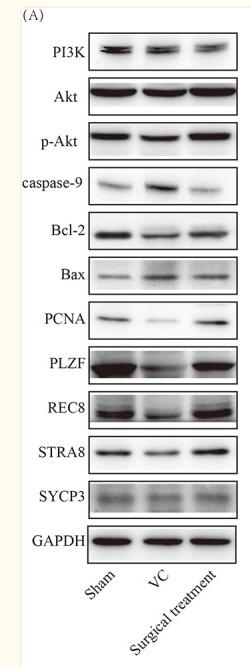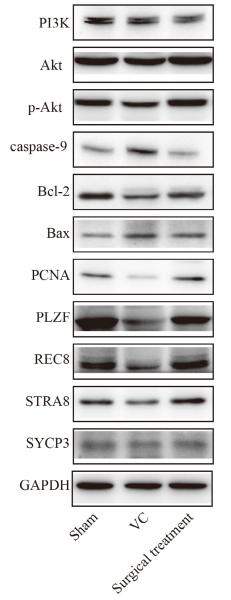SYCP3 Antibody - #DF2579
| 製品: | SYCP3 Antibody |
| カタログ: | DF2579 |
| タンパク質の説明: | Rabbit polyclonal antibody to SYCP3 |
| アプリケーション: | WB IHC |
| Cited expt.: | WB |
| 反応性: | Human, Mouse, Rat |
| 予測: | Pig, Bovine, Horse, Sheep, Chicken |
| 分子量: | 28-40kD; 28kD(Calculated). |
| ユニプロット: | Q8IZU3 |
| RRID: | AB_2839785 |
製品説明
*The optimal dilutions should be determined by the end user. For optimal experimental results, antibody reuse is not recommended.
*Tips:
WB: For western blot detection of denatured protein samples. IHC: For immunohistochemical detection of paraffin sections (IHC-p) or frozen sections (IHC-f) of tissue samples. IF/ICC: For immunofluorescence detection of cell samples. ELISA(peptide): For ELISA detection of antigenic peptide.
引用形式: Affinity Biosciences Cat# DF2579, RRID:AB_2839785.
折りたたみ/展開
choline phosphotransferase 1; chpt1; COR 1; COR1; MGC71888; RNASCP3; SCP 3; SCP-3; SCP3; SPGF4; Sycp 3; Sycp3; SYCP3_HUMAN; Synaptonemal complex protein 3;
免疫原
A synthesized peptide derived from human SYCP3, corresponding to a region within the internal amino acids.
- Q8IZU3 SYCP3_HUMAN:
- Protein BLAST With
- NCBI/
- ExPASy/
- Uniprot
MVSSGKKYSRKSGKPSVEDQFTRAYDFETEDKKDLSGSEEDVIEGKTAVIEKRRKKRSSAGVVEDMGGEVQNMLEGVGVDINKALLAKRKRLEMYTKASLKTSNQKIEHVWKTQQDQRQKLNQEYSQQFLTLFQQWDLDMQKAEEQEEKILNMFRQQQKILQQSRIVQSQRLKTIKQLYEQFIKSMEELEKNHDNLLTGAQNEFKKEMAMLQKKIMMETQQQEIASVRKSLQSMLF
種類予測
Score>80(red) has high confidence and is suggested to be used for WB detection. *The prediction model is mainly based on the alignment of immunogen sequences, the results are for reference only, not as the basis of quality assurance.
High(score>80) Medium(80>score>50) Low(score<50) No confidence
研究背景
Component of the synaptonemal complexes (SCS), formed between homologous chromosomes during meiotic prophase. Required for centromere pairing during meiosis in male germ cells (By similarity). Required for normal meiosis during spermatogenesis and male fertility. Plays a lesser role in female fertility. Required for efficient phosphorylation of HORMAD1 and HORMAD2 (By similarity).
Phosphorylated.
Nucleus. Chromosome. Chromosome>Centromere.
Note: It is present in early unpaired cores, in the lateral domains of the synaptonemal complex and in the chromosome cores when they separate at diplotene. It is found axial to the metaphase I chromosomes and in association with pairs of sister centromeres. The centromere-associated protein becomes dissociated from the centromeres at anaphase II and is not found in mitotic metaphase centromeres.
Testis-specific.
Composed of a long central coiled coil domain. The N-terminal and C-terminal regions interact with DNA.
Belongs to the XLR/SYCP3 family.
研究領域
· Genetic Information Processing > Replication and repair > Homologous recombination.
参考文献
Application: WB Species: Rat Sample: testicular tissues
Application: WB Species: rat Sample: Testicular
Restrictive clause
Affinity Biosciences tests all products strictly. Citations are provided as a resource for additional applications that have not been validated by Affinity Biosciences. Please choose the appropriate format for each application and consult Materials and Methods sections for additional details about the use of any product in these publications.
For Research Use Only.
Not for use in diagnostic or therapeutic procedures. Not for resale. Not for distribution without written consent. Affinity Biosciences will not be held responsible for patent infringement or other violations that may occur with the use of our products. Affinity Biosciences, Affinity Biosciences Logo and all other trademarks are the property of Affinity Biosciences LTD.


